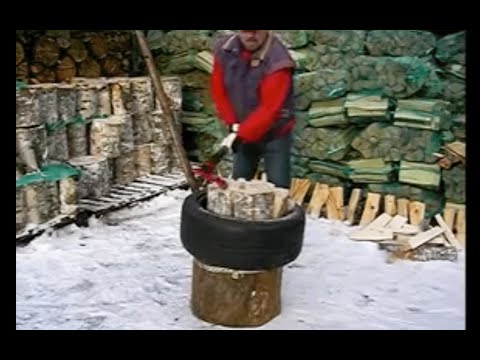
Sugerido por Ivan de Union
Do Phys.org
Finnish inventor rethinks design of the axe

Phys.org) —Finnish inventor Heikki Kärnä is the man behind the Vipukirves Leveraxe, which is a precision tool for splitting firewood. He designed the tool to make the job easier and more efficient, with no need for an external source of energy. In short, he has redesigned the axe. This is a lever-based axe. The axe head is attached to the handle from the side and not through the center. This results in the center of gravity of the axe head being to one side of the center line of strike. Leveraxe is based on a lever mechanism and rotational action.
“Everybody who has tried splitting wood with a traditional axe knows that it takes a lot of power to penetrate and split the wood,” according to the axe-maker, but with Kärnä’s invention you must loosen your grip when the axe, with its birch handle, hits the log, to allow for its levering movement. Each swing of the axe splits a piece of wood. The axe does not get stuck in the wood and holds it steady for the next swing. “You can easily and safely start splitting suitably sized logs from the sides by striking closer to edges. No more needing the futile first heavy strikes just to get the log split in two.”
The log website promotes safety features. The Leveraxe does not bounce wildly as might happen with a traditional axe, said the company. The axe changes the kinetic energy to rotational motion and is easier to control. As important, “the Leveraxe head cannot go ballistic.”
Should the axe head of a traditional detach from the handle and take off on a ballistic trajectory, there could be dangerous consequences. The inventor sought to eliminate that possibility, making the axe handle hole and handle asymmetric. He inserted the handle through the axe from the opposite direction than normally done, as a safety feature.

The videos that show his axe demonstrate how wood-splitting is done using a log-holding tire, for better ergonomics. (With a traditional axe, the site noted, using the tire on top the chop would be awkward and dangerous.) “When using a chopping block with a tire setup you can achieve a burst of strikes at a frequency of 100 strikes a minute. Thus, as an example, using 10 strikes to chop a log would take 6 seconds.” One of the questions in his FAQ, though, is if one always needs a car tire around the chopping block when using the Leveraxe. The answer is No, one can chop on rock or asphalt.”The best location is a half a meter (1.6 feet) tall chopping block. You can improve the result by using a tire in conjunction with the chopping block. You can fill the tire with logs and start chopping them one by one. This way the logs will stay stationary while chopping and you can lift them all at once and move them to dry in a pile. By using the tire technique you’ll save time, trouble and your back. It is best to use an extra wide tire in order to fit more and larger logs in it.”
As for electrical hydraulic splitters, yes, they are handy; one just needs to press a button, but he pointed to their shortcomings, being they require electricity availability and often needing long electrical extension cords and residual current circuit breaker (RCCB).

Read more at: http://phys.org/news/2014-04-finnish-inventor-rethinks-axe.html#jCp
Você pode fazer o Jornal GGN ser cada vez melhor.
Apoie e faça parte desta caminhada para que ele se torne um veículo cada vez mais respeitado e forte.



 produtos
produtos




E os canhotos?
Vai ter que ter dois modelos, um para destro e outro para canhoto…
Nao, o texto explica que por
Nao, o texto explica que por questao de seguranca o machado entra no cabo por cima e nao por baixo, portanto eh so colocar na outra posicao.
Traduzindo um pouco do item, nao sabia que ia virar post:
Inventor finlandes Keikki Karna eh o responsavel pelo “Leveraxe” (literalmente, “cunhachado”, mistura de duas palavras), que eh uma ferramenta de alta precisao para partir lenha. Ele o desenhou para facilidade e mais eficiencia, sem necessitar de uma fonte de energia externa. Em poucas palavras: ele reinventou o machado. Esse eh baseado na cunha. A cabeca fica ao lado do cabo e nao ao centro. Resulta se que o centro de gravidade do machado fica de um lado da machadada. Leveraxe eh baseado na cunha e acao rotacional.
“Todo mundo que ja cortou lenha com um machado sabe que requer muita forca penetrar e partir a madeira”, de acordo com Karna, mas com sua invencao voce relaxa o pulso quando a machadada acerta a madeira para que o peso fora do centro aja como uma cunha. Cada machadada eh um corte. Ele nao fica preso aa madeira e a segura aberta para a proxima machadada.
O site promove a seguranca. O Leveraxe nao pula pra la e pra ca como um machado normal, diz a compania. Ele troca a energia quinetica (da machadada) pelo movimento rotacional, e eh mais facil controlar. Tao importante quanto isso eh a cabeca do machaco, que nao sai voando aleatoriamente.
E pra cortar na horizontal?
Será também bom?
Nao no sentido de “serra
Nao no sentido de “serra eletrica” porque aa batida do machado, ele se vira de lado, isso eh, ele corta em “v”s, exceto que a segunda metade do “v” tem que ser feita do outro lado da tora, claro. Isso dito, a precisao pra qualquer corte tem alta chance de ser bem melhor que a de um machado normal.
Achei útil o post
E gostaria de um cunhachado por aqui (nós aproveitamos uns pinheiros derrubados para fazer lenha)
Pela figura inicial dá a impressão de que é possível encaixar ao contrário, para atender canhotos.
Gostaria de uma demostração
Gostaria de uma demostração com angico ou pau-ferro, madeiras aqui do Rs.
Pau-ferro nao conheco, mas
Pau-ferro nao conheco, mas com angico seria otima!!!
Não reinventou o machado
Este machado diferente funciona muito bem para partir lenha no sentido das fibras da madeira. Ele não mostrou o corte feito perpendicular a fibra, como se fosse derrubar uma árvore. Mas para isto é mais indicado o uso de uma motosserra.
comprar
Bom dia, eu gasto muita lenha dessa forma aqui no RS (BRASIL) como posso comprar um deses machados?